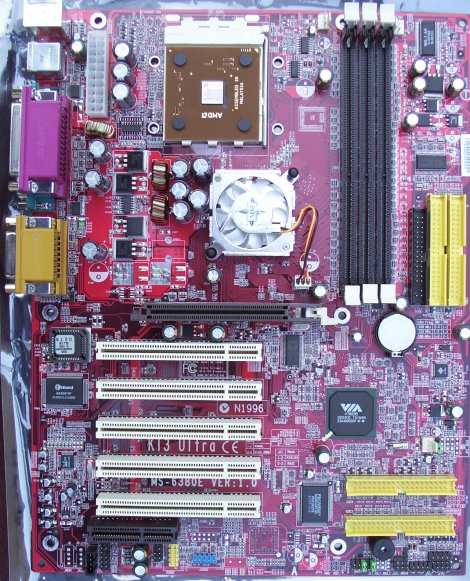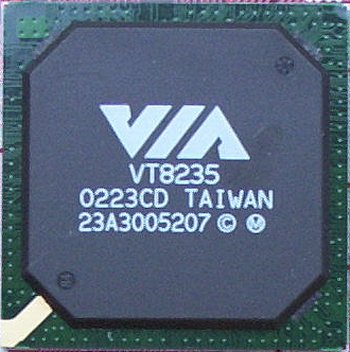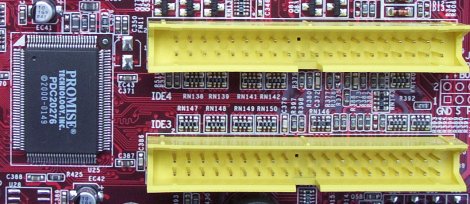Layout and features

We'll continue our tradition of evaluating motherboards by starting at the top and working our way down, highlighting the salient points on the way.
The location of the main ATX power connector is good, the trailing wires keep out of harm's way. There is more than enough space around the socket to mount a larger cooler should you so desire. You can see how clutter-free the socket area is. Unlike some competing Intel chipsets, you are given the luxury of 3 DDR DIMM slots housing 184-pin DDR memory. 3GB is on offer with support for DDR333 memory (not CPU FSB) out-of-the-box.
It's strange how reminiscent this motherboard is to its predecessor, the KT3 Ultra. Looking at pictures of them sitting alongside each other, one would find it extremely difficult to tell them apart. It appears as if this was an extremely easy transition from one motherboard to the other. They share the same layout and the same stylish North Bridge fan.
The main IDE and floppy ports sit in a sensible location to the left of the motherboard, probably just above the drives that they will service.

Interestingly, just like the KT3 Ultra, this motherboard has the same CPU FSB options printed on the PCB. You can supposedly choose a CPU FSB of 166MHz (5:1 FSB:AGP divisor) but just like the KT3 Ultra, I can't find the switches anywhere on the motherboard, a rather academic inclusion.

The VT8235 South Bridge, along with the Bluetooth support, is what largely differentiates this from its predecessor. Notable improvements over the VT8233A found on other KT333-based motherboards are in-built support for USB2.0. A total of six ports can be used and are offered (2 on the backplane, 2 via the D-Bracket2 and 2 from a header). Additionally, the VT8235 has an improved transfer link to the North Bridge (533MB/s against 266MB/s for the VT8233A). As VIA implement what they call a V-MAP architecture, the South Bridges are pin-for-pin compatible. Other features of this SB include 6-channel audio, ATA133 support and 10/100 ethernet support.
The inclusion of 5-PCI slots is disappointing in view of the fact that a potential slot is sacrificed in order to accommodate a CNR slot. I'm not a fan of these and would much rather have seen a full complement of PCI slots.

RAID is provided by the popular Promise PDC20276 chipset. The downside to the particular one on offer is that it is identified as the MBFastTrack Lite 133. Although it supports up to four hard drives, only two can be used in either RAID 0 or RAID 1 modes. Therefore, it supports RAID 0, RAID 1 but not RAID 0+1.
Another major drawback of this controller is the limitation of strip size to 64KB. I would have preferred the Highpoint RAID controller for its flexibility, and more specifically, the Highpoint HPT374 8-channel controller as found on the ABIT MAX 'boards.

The premium on-board sound CODEC of choice is once again the Realtek ALC650. This supports a maximum of 6 discrete channels (Left, Right, Center, SL, SR and Sub), It also supports S/PDIF out (which is provided via the S-Bracket). From basic listening it appears as if it's more than capable of basic Windows duty. The only downside of on-board sound is that it inevitably takes a toll on absolute performance.

The backplane appears standard enough. The one aspect that disappoints me is the lack of on-board LAN. I'm used to premium MSI motherboards incorporating this either through the South Bridge (the VT8235 does have on-board LAN, it simply needs to be routed) or by a dedicated controller, usually the Realtek 8139.
Overall, this seems to be a simple and effective update of the KT3 Ultra. It's well-specified but a couple of points detract from its attractiveness.









